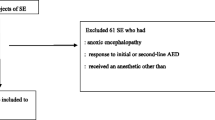Abstract
Background
Refractory status epilepticus (RSE) is often treated with continuous intravenous medications with the goal of EEG burst suppression. Standard advice is to titrate medications to at least 10-s interburst intervals; however, this has not been shown to improve outcome. We examined EEG characteristics in patients treated with IV anesthetic therapy (IVAT) for RSE to determine which EEG characteristics were associated with successful lifting of IVAT (i.e., without recurrence of status epilepticus).
Methods
We screened the clinical continuous EEG database for adult patients treated with IVAT for RSE (excluding patients with anoxic injury). We measured the length of bursts and interburst intervals for each patient, calculated EEG burst suppression ratios, and graded bursts for the amount of epileptiform activity. We compared these characteristics in successful versus unsuccessful IVAT lifting attempts.
Results
We included 17 successful and 20 unsuccessful lifting attempts in 19 patients (5 used as a holdout validation set). The interburst intervals, burst suppression ratios, and length of bursts did not differentiate successful and unsuccessful lifting attempts; the amount of epileptiform activity in bursts correlated with success or failure to wean IVAT (p = 0.008). Maximum burst amplitude <125 μV had 84.6 % sensitivity and 61.1 % specificity for predicting successful lifting.
Conclusion
The length of interburst intervals and burst suppression did not predict successful termination of RSE in this small cohort. This may suggest that EEG characteristics, rather a strict interburst interval goal, could guide IVAT for RSE.



Similar content being viewed by others
References
Hirsch LJ, Gaspard N. Status epilepticus. Continuum. 2013;19:794–7.
Allredge BK, Gelb AM, Isaacs SM, et al. A comparison of lorazepam, diazepam, and placebo for the treatment of out-of-hospital status epilepticus. NEJM. 2001;345:631–7.
Brophy GM, Bell R, Claassen J, et al. Guidelines for the evaluation and management of status epilepticus. Neurocrit Care. 2012;17:3–23.
Rossetti AO, Logroscino G, Bromfield EB. Refractory status epilepticus: effect of treatment aggressiveness on prognosis. Arch Neurol. 2005;62:1698–702.
Rossetti AO, Reichhart MD, Schaller M, Despland P, Bogousslavsky J. Propofol treatment of refractory status epilepticus: a study of 31 episodes. Epilepsia. 2004;45:757–63.
Rossetti AO, Lowenstein DH. Management of refractory status epilepticus in adults: still more questions than answers. Lancet Neurol. 2011;10:922–30.
Sahin M, Menache CC, Holmes GL, Riviello JJ Jr. Prolonged treatment for acute symptomatic refractory status epilepticus: outcome in children. Neurology. 2003;61:398–401.
Krishnamurthy KB, Drislane FB. Depth of EEG suppression and outcome in barbiturate anesthetic treatment for refractory status epilepticus. Epilepsia. 1999;40:759–62.
Hocker SE, Britton JW, Mandrekar JN, Wijdicks EF, Rabinstein AA. Predictors of outcome in refractory status epilepticus. JAMA Neurol. 2013;70:72–7.
Kowalski RG, Ziai WC, Rees RN, et al. Third-line antiepileptic therapy and outcome in status epilepticus: the impact of vasopressor use and prolonged mechanical ventilation. Crit Care Med. 2012;40:2677–84.
Sutter R, Kaplan PW, Marsch S, Hammel EM, Ruegg S, Ziai WC. Early predictors of refractory status epilepticus: an international two-center study. Eur J Neurol. 2015;22:79–85.
Fernandez A, Lantigua H, Lesch C, et al. High-dose midazolam infusion for refractory status epilepticus. Neurology. 2014;82:359–65.
Rossetti AO, Logroscino G, Milligan TA, Michaelides C, Ruffieux C, Bromfield EB. Status epilepticus severity score: a tool to orient early treatment strategy. J Neurol. 2008;255:1561–6.
Trinka E, Cock H, Hesdorffer D, et al. A definition and classification of status epilepticus—report of the ILAE task force on classification of status epilepticus. Epilepsia. 2015;56:1515–23.
Bergey GK. Refractory status epilepticus: is EEG burst suppression an appropriate treatment target during drug-induced coma? what is the holy grail? Epilepsy Curr. 2006;6:119–20.
Hofmeijer J, Beernink T, Bosch F, et al. Early EEG contributes to multimodal outcome prediction of postanoxic coma. Neurology. 2015;85:137–43.
Akrawi WP, Drummond JC, Kalkman CJ, Patel PM. A comparison of the electrophysiologic characteristics of EEG burst-suppression as produced by isoflurane, thiopental, etomidate, and Propofol. J Neurosurg Anesthesiol. 1996;8:40–6.
Landis JR, Koch GG. The measurement of observer agreement for categorical data. Biometrics. 1977;33:159–74.
Mani R, Arif H, Hirsch LJ, Gerard EE, LaRoche SM. Interrater reliability of ICU EEG research terminology. J Clin Neurophysiol. 2012;29:203–12.
Thompson SA, Hantus S. Highly epileptiform bursts are associated with seizure recurrence. J Clin Neurophysiol. 2016;33:66–71.
Sutter R, Marsch S, Fuhr P, Kaplan P, Ruegg S. Anesthetic drugs in status epilepticus: risk or rescue? A 6-year cohort study. Neurology. 2014;25:656–64.
Gaspard N, Foreman BP, Alvarez V, et al. New-onset refractory status epilepticus: etiology, clinical features, and outcome. Neurology. 2015;85:495–500.
Claassen J, Hirsch LJ, Emerson RG, Mayer SA. Treatment of refractory status epilepticus with pentobarbital, propofol, or midazolam: a systematic review. Epilepsia. 2002;43:146–53.
Kang BS, Jung KH, Wu C, et al. Induction of burst suppression or coma using intravenous anesthetics in refractory status epilepticus. J Clin Neurosci. 2015;22:854–8.
Author information
Authors and Affiliations
Corresponding author
Ethics declarations
Conflict of Interest
The authors declare that they have no conflicts of interest.
Research Involved in Human Participants
All procedures performed in studies involving human participants were in accordance with the ethical standards of the Institutional and/or National Research Committee and with the 1964 Helsinki Declaration and its later amendments or comparable ethical standards.
Rights and permissions
About this article
Cite this article
Johnson, E.L., Martinez, N.C. & Ritzl, E.K. EEG Characteristics of Successful Burst Suppression for Refractory Status Epilepticus. Neurocrit Care 25, 407–414 (2016). https://doi.org/10.1007/s12028-016-0294-2
Published:
Issue Date:
DOI: https://doi.org/10.1007/s12028-016-0294-2




